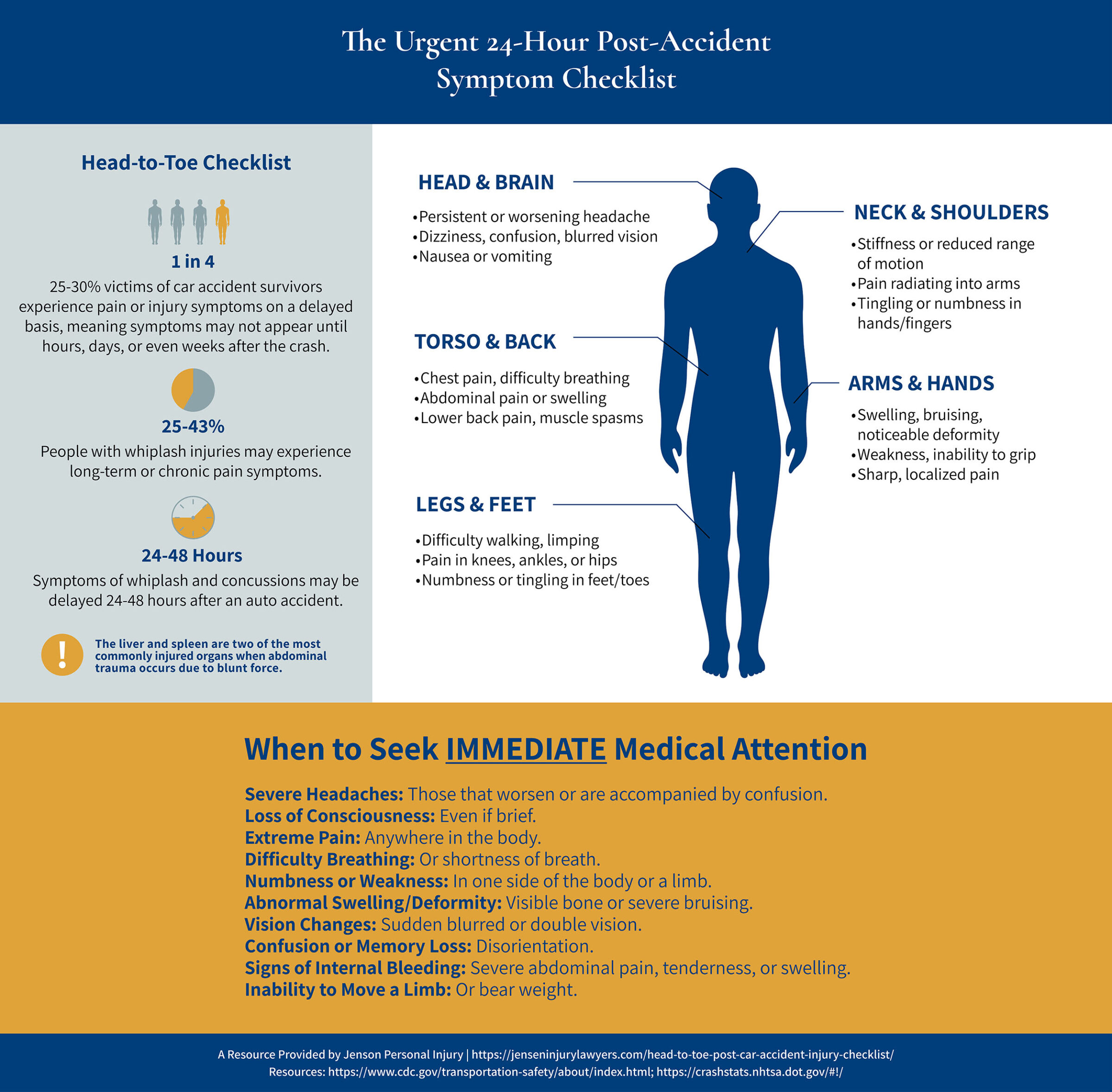The immediate aftermath of a car accident is often a chaotic mix of shock, adrenaline, and confusion. While some injuries are instantly obvious, many dangerous conditions, known as delayed post-car accident injuries, can remain hidden for hours or even days. The physiological response to trauma can mask pain, leading people to believe they are fine when serious issues are developing. This comprehensive head-to-toe checklist is designed as an essential educational tool to help you monitor your body for symptoms in the crucial first 24 hours following a collision.
If you begin to notice symptoms, even days after the crash, it’s important to speak not only with a doctor but also with a car accident lawyer. A legal professional can help you understand your rights, especially if delayed injuries impact your ability to work, move, or enjoy daily life.
Always remember: this information is not a substitute for professional medical evaluation. If you’ve been in an accident, seeking medical attention is your absolute priority.
Why is Checking for Post-Car Accident Injuries So Important?
Even seemingly minor collisions can result in significant trauma. The impact of a crash, even at low speeds, can exert immense force on the body, leading to a variety of injuries. Understanding why a diligent self-assessment is vital can empower you to take necessary preventative steps for your health.
- The Adrenaline Rush: In stressful situations like a car accident, your body floods with adrenaline and endorphins. These natural painkillers can effectively mask pain and discomfort, making you feel less injured than you actually are. This temporary numbness can, unfortunately, delay the recognition of serious conditions.
- Delayed Onset Symptoms: Many common post-car accident injuries don’t manifest immediately. Conditions like whiplash, concussions, or even internal bleeding can develop or worsen over 12-48 hours. What might feel like a minor stiffness initially could evolve into debilitating pain or indicate a more serious underlying issue.
- Preventing Worsening Conditions: Early detection of symptoms, even subtle ones, allows for prompt medical intervention. Addressing injuries quickly can prevent them from becoming more severe, chronic, or leading to long-term health complications.
- Comprehensive Assessment: A structured checklist helps ensure you don’t overlook any potential area of concern. From head trauma to foot injuries, every part of your body is vulnerable in a collision.
Here’s Our Head-to-Toe Checklist for Post-Accident Injuries
Identifying hidden car accident injuries is often a matter of vigilance and knowing what to look for. The following checklist breaks down the most common delayed symptoms by body region, serving as a practical guide for self-monitoring in the first 24 hours.

Head and Brain Injuries
The head is incredibly vulnerable in a car accident. Even without direct impact, the sudden jerking motion can cause the brain to collide with the inside of the skull, commonly resulting in serious injuries
- Concussion: This traumatic brain injury (TBI) can manifest with persistent headaches, dizziness, nausea, confusion, sensitivity to light or sound, memory issues, or changes in mood/sleep patterns. Symptoms can appear hours after impact.
- Scalp Lacerations/Bruising: Check for any cuts, scrapes, or tender areas on your scalp.
- Jaw Pain: Clenching the jaw during impact can lead to TMJ dysfunction or fractures.
Neck and Shoulder Injuries
One of the most common post-car accident injuries is whiplash, but other serious conditions can affect the neck and shoulders.
- Whiplash: Caused by the forceful back-and-forth movement of the neck, which is similar to the cracking of a whip. Symptoms include neck stiffness, pain (often delayed), limited range of motion, headaches starting at the base of the skull, and pain radiating down to the shoulders or arms.
- Shoulder Sprains/Strains: Seatbelt impact or bracing for impact can injure the shoulder joint, rotator cuff, or surrounding muscles. Look for localized pain, bruising, or difficulty moving the arm.
- Pinched Nerves: Tingling, numbness, or weakness in the arms or hands can indicate a nerve impingement in the neck or shoulder.
Torso and Back Injuries
The torso is protected by seatbelts, but the force of a crash can still cause significant internal and external damage. The spine is also highly susceptible to injury.
- Chest Pain: If the seatbelt tightened forcefully, you might experience bruising or fractured ribs. Airbag deployment can also cause chest injuries. Difficulty breathing should be taken seriously.
- Abdominal Pain: Internal injuries, such as organ damage or internal bleeding, may not be immediately obvious. Look for abdominal tenderness, swelling, or unusual pain.
- Spinal Injuries: Back pain is a frequent complaint after a car accident. This can range from muscle strains to more severe issues like herniated discs, slipped discs, or even vertebral fractures. Symptoms include localized back pain, pain radiating down the legs (sciatica), numbness, or weakness in the limbs.
Arms and Hands Injuries
Instinctively, people brace for impact with their arms and hands, making them vulnerable to injury.
- Fractures and Dislocations: The force of the impact can lead to broken bones in the wrists, forearms, or hands, or dislocations of joints. Look for swelling, deformity, severe pain, or inability to move the limb.
- Sprains and Strains: Damage to ligaments and muscles in the wrists, elbows, or shoulders.
- Lacerations and Contusions : Contact with the dashboard, steering wheel, or shattered glass can cause cuts and bruises.
Legs and Feet Injuries
Leg and foot injuries are common, especially from impact with the dashboard, steering column, or vehicle floor.
- Knee Injuries: Often referred to as “dashboard knee,” direct impact can cause fractures, ligament tears (like ACL or PCL), or meniscal tears. Look for swelling, pain, or difficulty bending/straightening the knee.
- Ankle and Foot Fractures/Sprains: The sudden force can twist ankles or fracture bones in the feet. Check for swelling, bruising, severe pain, or inability to bear weight.
- Hip Injuries: Dislocation or fracture of the hip can occur from severe impact, often radiating pain to the groin or thigh.
When Post-Car Accident Injuries Need Immediate Medical Attention
Some post-car accident injuries may seem minor at first, but certain symptoms can signal a serious or even life-threatening condition. It’s crucial to recognize when these injuries require emergency care. If you notice any of the following signs after a crash, seek immediate medical attention:
- Loss of Consciousness: Even if brief.
- Severe Headaches That Worsen: Especially if accompanied by confusion, dizziness, or vomiting.
- Extreme Pain: Any pain that is excruciating or rapidly intensifying.
- Difficulty Breathing: Or persistent shortness of breath.
- Numbness or Weakness: Especially if it affects one side of the body or a limb, which could indicate neurological damage.
- Visible Deformity or Abnormal Swelling: Suggesting a fracture or serious soft tissue injury.
- Confusion or Memory Loss: Disorientation about time, place, or recent events may indicate that you have suffered a concussion
- Signs of Internal Bleeding: Severe abdominal pain, tenderness, swelling, or blood in urine/stool.
- Inability to Move a Limb: Or to bear weight on a leg or arm.
- Vision Changes: Sudden blurred vision, double vision, or loss of vision.
Take Care of Yourself and Your Loved Ones
The moments and days following a car accident are crucial for your physical recovery. Being informed about potential delayed post-car accident injuries allows you to be proactive about your health. Listen to your body, don’t ignore subtle symptoms, and always prioritize seeking medical attention from qualified professionals. Your well-being is the most important consideration.
Remember, this checklist serves as a guide for self-awareness. Your health and safety are always the top priority. Please feel free to share this resource with friends, family, or anyone who might benefit from understanding post-car accident injuries.
You don’t have to navigate this alone. Reach out for a free, compassionate consultation. No pressure, just answers.
